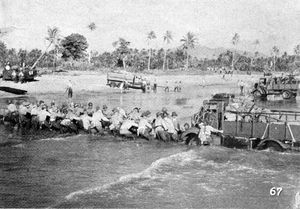
Back حملة الهند الشرقية الهولندية Arabic Campaña de les Indies Orientales Neerlandeses AST Операция в Нидерландска Индия Bulgarian Boje o Nizozemskou východní Indii (1941–1942) Czech Campaña de las Indias Orientales Neerlandesas Spanish لشکرکشی هند شرقی هلند Persian Hollannin Itä-Intian taistelut Finnish Invasion des Indes orientales néerlandaises French קרב איי הודו המזרחיים HE Kampanye Hindia Belanda ID
| Dutch East Indies campaign | |||||||||
|---|---|---|---|---|---|---|---|---|---|
| Part of the Pacific Theatre of World War II | |||||||||
 Japanese forces land on Java. | |||||||||
| |||||||||
| Belligerents | |||||||||
|
|
| ||||||||
| Commanders and leaders | |||||||||
|
|
| ||||||||
| Strength | |||||||||
|
148,000[2] 33 warships[5]41 submarines[6] 234 aircraft[3] |
52 warships[7][8] 18 submarines[6] 107,800 personnel 193 tanks & tankettes 2,017 guns & mortars 5,898 motor vehicles 11,750 horses 609 aircraft[9] | ||||||||
| Casualties and losses | |||||||||
|
2,384 killed 1 seaplane tender 2 heavy cruisers 3 light cruisers 1 coastal defense ship 15 destroyers 1 oil tanker 1 gunboat 5,000–10,000 sailors and Marines killed on the sunken ships thousands of sailors and Marines captured[11] | 671 killed[12] | ||||||||
The Dutch East Indies campaign of 1941–1942 was the conquest of the Dutch East Indies (present-day Indonesia) by forces of the Empire of Japan in the early days of the Pacific campaign of World War II. Allied forces attempted unsuccessfully to defend the islands. The East Indies were targeted by the Japanese for their rich oil resources which would become a vital asset during the war. The campaign and subsequent three-and-a-half-year Japanese occupation was also a major factor in the end of Dutch colonial rule in the region.
- ^ Dutch military commanders and the Governor-General surrendered on 9 March. Adrian Vickers, 2005, A History Modern of Indonesia, Cambridge; Cambridge University Press, p. 87.
- ^ Does not include naval personnel
- ^ a b c "Chapter 10: Loss of the Netherlands East Indies". The Army Air Forces in World War II: Vol. 1 – Plans & Early Operations. HyperWar. Archived from the original on 7 April 2010. Retrieved 31 August 2010.
- ^ George McTurnan Kahin and Adrian Kahin, Subversion as Foreign Policy, New York: The New Press, 1995 (ISBN 1565842448), Pp 22
- ^ Morison (1948), pp. 158, 271–273, 293 and 311
- ^ a b "Submarine War in the Dutch East Indies (1941–1942)". Forgotten Campaign: The Dutch East Indies Campaign 1941–1942. 1999–2000. Archived from the original on 16 April 2021. Retrieved 31 August 2010.
- ^ Morison (1948), pp. 274– 276, 296, 384
- ^ Morison (1948), pp. 275–276
- ^ War History Office of the National Defense College of Japan; Willem Remmelink, trans., The Invasion of the Dutch East Indies Archived 2017-03-11 at the Wayback Machine (Leiden University Press, 2015) pp. 95, 98, 417. Retrieved 11/21/2017
- ^ "World War II: The Defensive Phase" Archived 2019-07-12 at the Wayback Machine, US Army Center Of Military History, p. 87
- ^ Records for an accurate count of how many killed, wounded, and captured from the 24 sunken ships were not available due to the destruction of the fleet. Many of the ships' crewmen were captured by the Japanese and the fate of the lost ships were unknown for many years.
- ^ Francis Pike, "Hirohito's War: The Pacific War, 1941–1945" Archived 2023-04-11 at the Wayback Machine, 2015, p. 309.